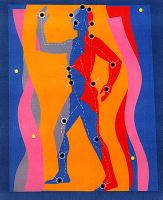Improvement in symptoms with acupuncture treatment of COPD
 Last year, the Canadian Thoracic Society clinical practice guidelines, advised there was insufficient evidence to support the routine use of acupuncture to treat chronic obstructive pulmonary disease (COPD).
Last year, the Canadian Thoracic Society clinical practice guidelines, advised there was insufficient evidence to support the routine use of acupuncture to treat chronic obstructive pulmonary disease (COPD).
Since then, 2 more studies have been published.
The COPD-Acupuncture Trial (CAT)
- 68 COPD patients from the Kansai region of Japan receiving standard medication were randomly assigned to a treatment group for 12 weeks.
- Traditional acupuncture
- Placebo needling at the same acupoints once a week
- Changes in the modified Borg scale score (0 = none to 10 = maximal dyspnea) evaluated immediately after the 6-minute walk test.
- Measurements were obtained at baseline and after 12 weeks of treatment.
And the results.
- After 12 weeks, the Borg scale score after the 6-minute walk test was significantly better with real acupuncture.
- The average difference between groups was 4.
- Patients with COPD who received real acupuncture also experienced improvement in the 6-minute walk distance during exercise, indicating better exercise tolerance and reduced dyspnea on exertion.
University College of Dublin, in Ireland
- 60 patients with COPD were randomly assigned to a treatment group.
- Controls
- Pulmonary rehabilitation
- Acupuncture plus pulmonary rehabilitation
- The primary outcome measured was a change in systemic inflammation at the end of pulmonary rehabilitation and at the 3-month follow-up.
- Lung function, including maximum inspiratory pressure, quality-of-life scores, functional capacity including steps taken, dyspnea, and exercise capacity, were also recorded.
And, the results.
- After pulmonary rehabilitation, both groups that received treatment had significant improvement in the following outcomes.
- Quality-of-life scores
- Reduced dyspnea scores
- Improved exercise capacity, and maximum inspiratory pressure
- There was no change in systemic inflammation vs the controls (no treatment).
- There were no differences in most of the outcome measures between the 2 treatment groups except that participants who had acupuncture and pulmonary rehabilitation remained less breathless for a longer period.
The bottom line?
The researchers in Japan concluded, “This study clearly demonstrates that acupuncture is a useful adjunctive therapy in reducing dyspnea on exertion in patients with COPD.”
The researchers in Ireland concluded, “The addition of acupuncture to pulmonary rehabilitation did not add significant benefit in most of the outcomes measured.”
The differences in conclusions are influenced by the primary endpoints defined before the study started. Both studies showed improvement in COPD symptoms. But the researchers in Ireland looked primarily for changes in underlying pathology as reflected in less inflammation. By comparison, the researchers in Japan looked for improved symptom control.
OK, acupuncture doesn’t appear to affect inflammation. But when you’re exhausted and breathless after walking across the room and can’t take a deep breath without coughing, offering an adjunctive treatment (acupuncture) to improve those basic symptoms makes a pretty compelling argument.
6/4/12 20:17 JR